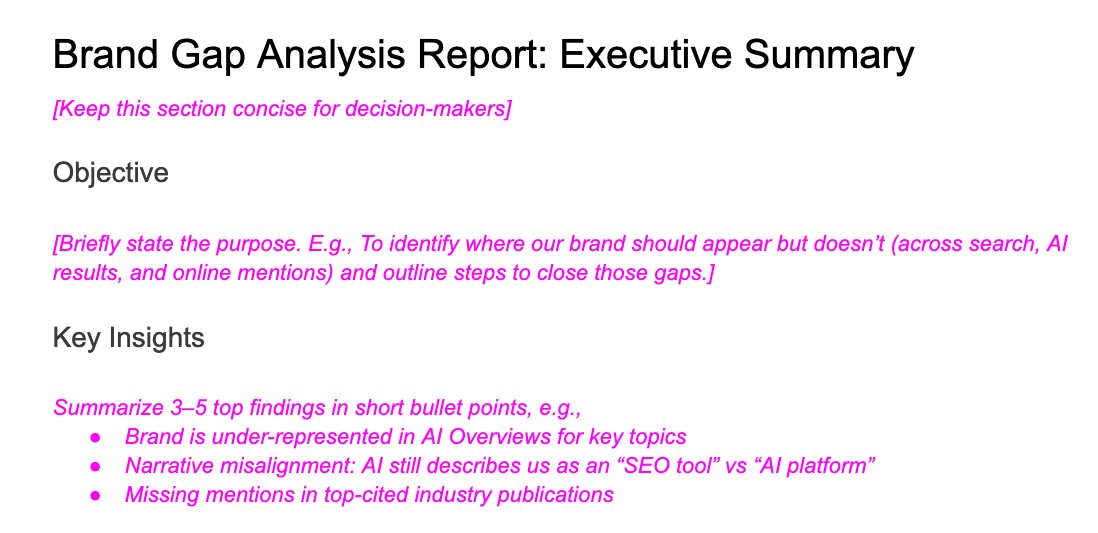Your brand presence shouldn’t depend on luck, algorithms, or guesswork. It should be built and improved with precision so you show up in all the places that matter, exactly as you want to be represented.
That’s what a brand gap analysis enables. It also turns brand visibility from a vague concept into something measurable and fixable. Here’s how.
content gap analysis (which focuses on missing keywords or pages), a brand gap analysis examines every factor shaping discoverability and reputation, from how AI describes you to which competitors are cited instead.
Brand Gap Analysis Report Template, a customizable framework to share visibility gaps, AI mentions, and opportunities for growth with stakeholders.
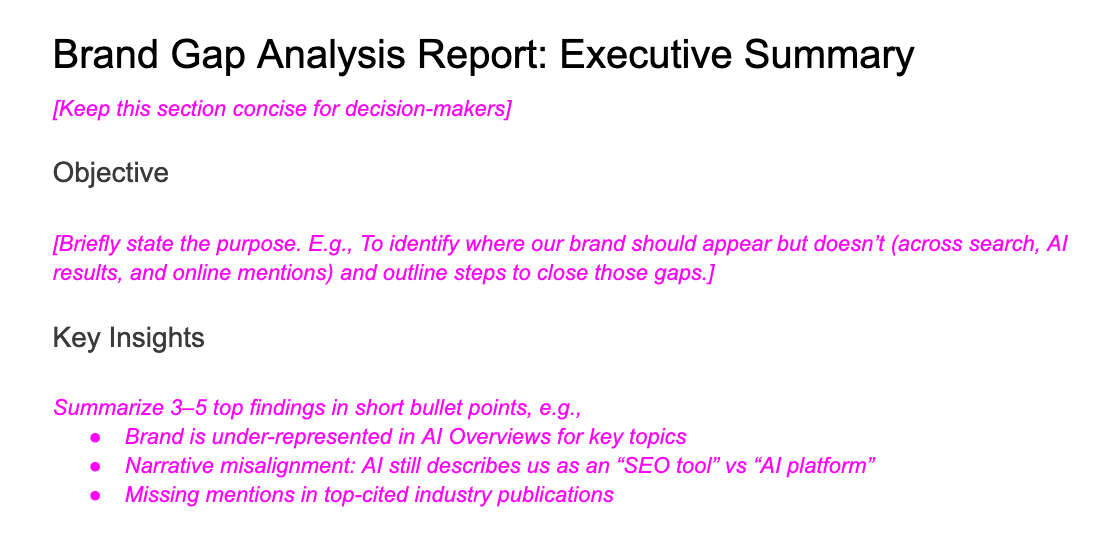
It includes:
- An executive summary format for leadership reporting
- Scoring tables for AI + search visibility
- Competitor insights stakeholders may be interested in
- An action plan and notes section to document next steps
Use it to make your brand’s visibility story easy to analyze, explain, and act on. Follow the process below to help you fill out each section with valuable insights.
connect each entity to the topics, features, and attributes people actually associate with them, like the problems they solve, the qualities they’re praised for, and the context they belong in.
A good starting point is keyword research.
Look for recurring adjectives, modifiers, questions, and descriptive phrases people use alongside your brand or category — terms like “affordable,” “eco-friendly,” “AI-powered,” or “award-winning.” For example, IDEO has connected its brand to “human-centred” design:

These reveal the values and attributes your audience already cares about, which you can then reinforce through messaging, content, and brand signals.
For example, when looking for lawyers, many people value a firm’s ability to win without it racking up major expenses in the process:

For a plumbing service, they value a plumber who can help them at any time during an emergency:
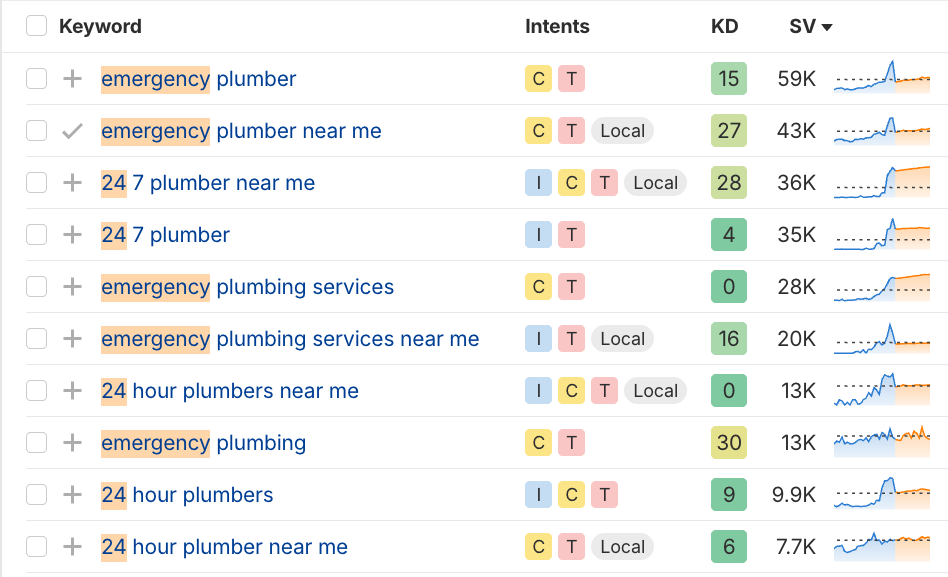
You get the idea.
If you’re not sure what topics people search for that your brand can target, try validating some ideas through Ahrefs’ free keyword generator:
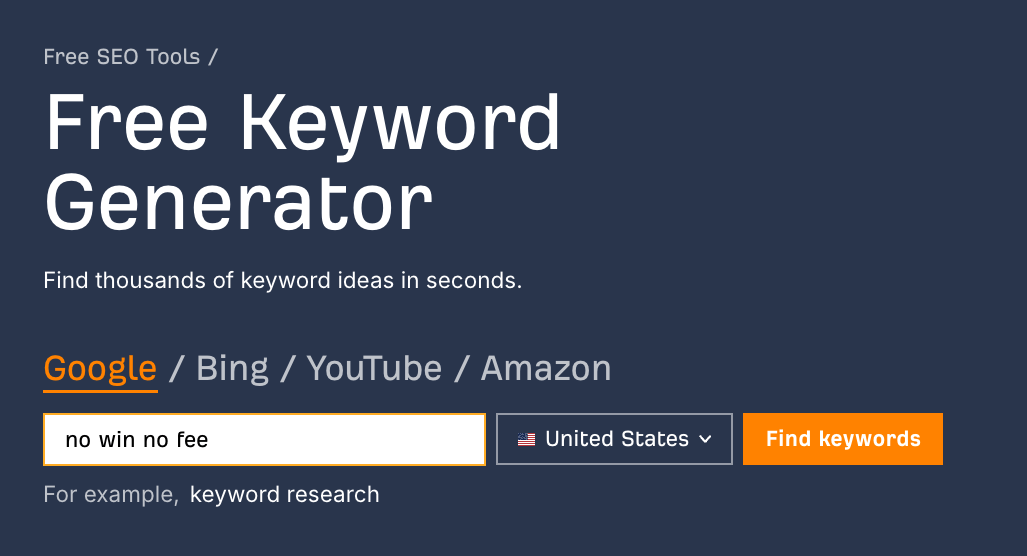
You’ll get a rough idea of the types of things people search for and how often:
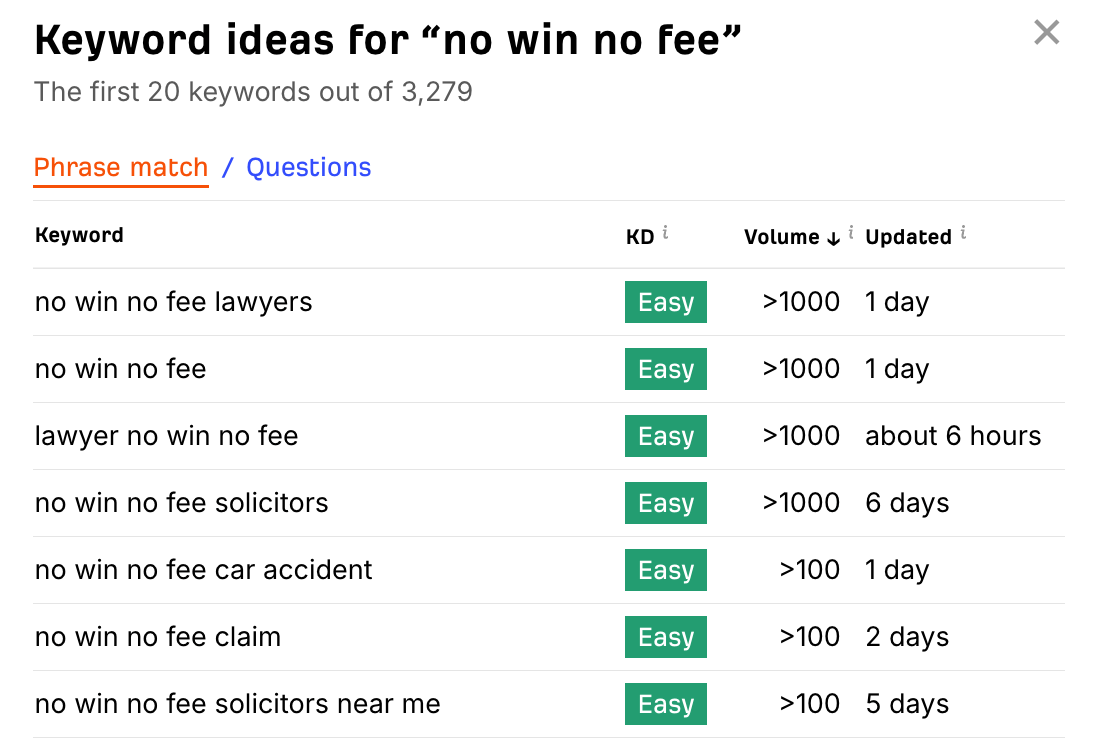
As you uncover these topics and values, capture them in a structured list. They’ll serve as your benchmark for what your brand should be known and found for.
In the next step, you’ll compare this “desired state” to your brand’s actual visibility to pinpoint the gaps.
Site Explorer. You’ll get a dashboard of metrics giving you a decent baseline.
For example, you’ll get a snapshot of metrics for search performance on Google, including:
- Domain Rating (DR): A measure of the website’s strength and authority online.
- Backlinks: The number of links around the web going to the brand’s website.
- Organic keywords: The number of keywords the brand ranks for in Google search (without paying for ads).
- Organic traffic: The estimated traffic earned from organic rankings in Google search.
- Organic traffic value: The equivalent cost to earn the same traffic via Google Ads.

You’ll also get a bird’s-eye view of the brand’s visibility in AI search across different platforms:

Clicking any of these metrics will take you to Ahrefs’ Brand Radar, which shows more specific metrics related to your brand’s visibility in AI search:

- Mentions: The number of times your brand is mentioned in AI responses.
- Citations: The number of times your brand’s website is cited as a source in AI responses.
- Impressions: An estimation of exposure based on how often responses containing your brand are shown in search results.
- AI Share of Voice: How often your brand is mentioned in AI responses compared to competitors.
You can track any metrics you think matter to your stakeholders.
The list above is the minimum to get you started. It’s also a great list to revisit periodically to see how your brand’s visibility changes over time and to report the results of your efforts.
Keywords Explorer and go to the Matching terms report:
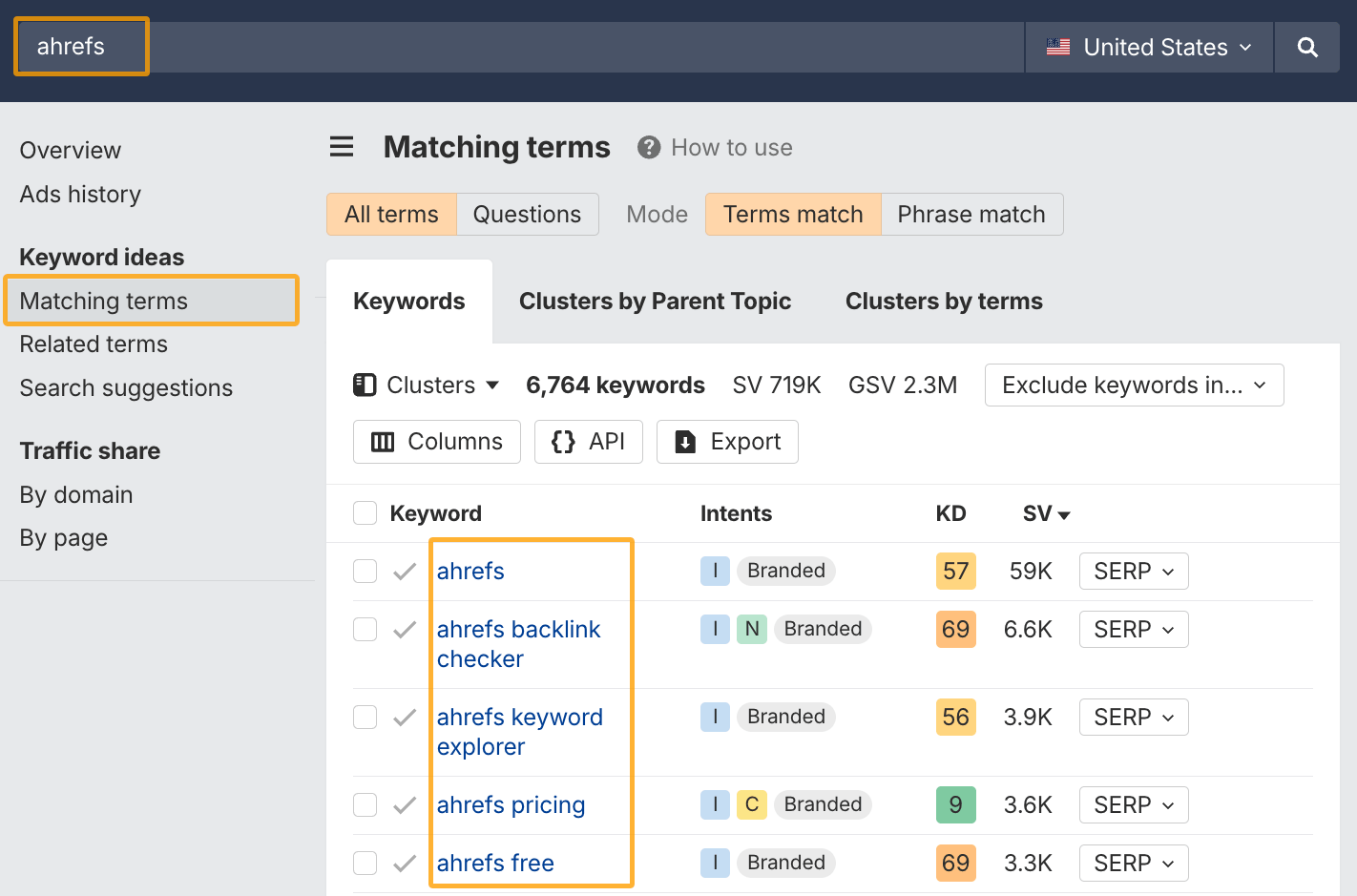
You’ll see a list of all branded terms that people search for. This report is a goldmine of brand data that comes directly from users.
You can see exactly what topics, features, and products people associate with your brand. You can also see what other brands your audience considers to be your competition.
Use the Target filter and add your brand’s website to see how well you rank for these terms:

The ideal outcome is for your website to rank in position one for all your branded keywords. But that’s not always going to be the case.
For any query containing your brand name where you’re not in the top spot, ask:
- Is the higher-ranking page from a competitor or third-party review site?
- Is it a “brand + competitor” comparison query where they outrank you?
- Is your YouTube, LinkedIn, or other owned asset ranking instead of your main site (and that’s acceptable)?
These are your branded search gaps. For each one, decide whether it’s worth closing and how to do it.
For example, for the keyword “Ahrefs YouTube”, the website ranks in position two, but by examining the search results, our branded YouTube profile ranks above the website (as expected), and therefore, there’s no gap for us to close.
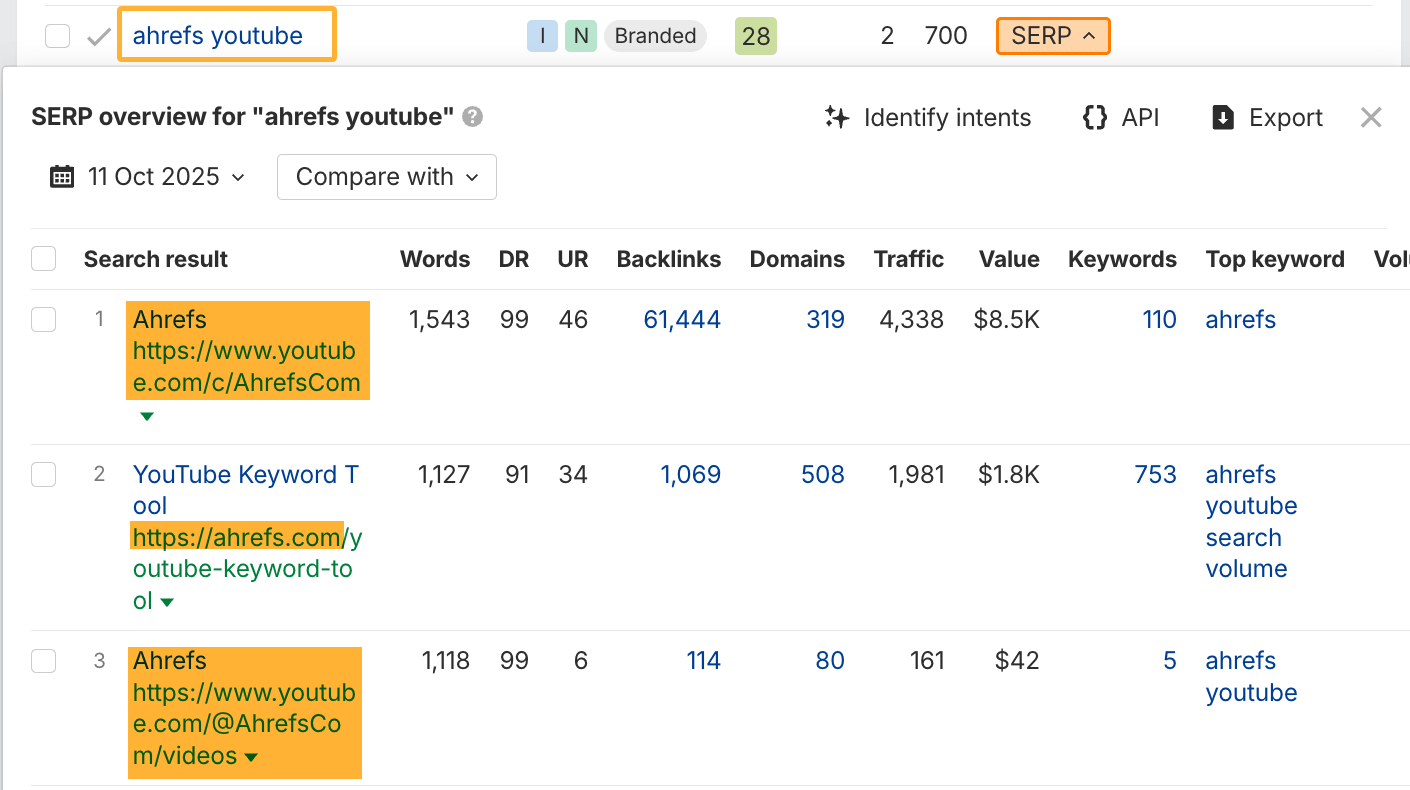
However, there are quite a lot of keywords about the paraphrasing tool with decent search volumes for which the website does not rank:
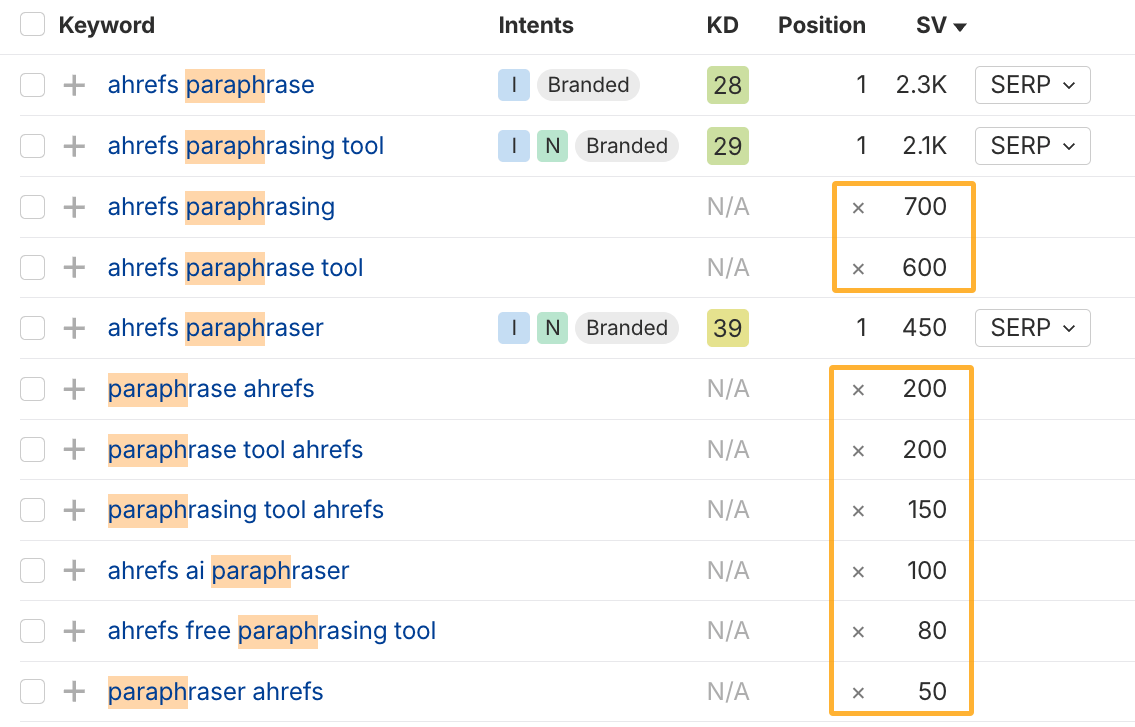
In this case, it may be worth improving the on-page optimization of the page to address these gaps.
Next, take a look at how your brand performs for related unbranded searches.
Start with the list of topics you identified as relevant to your brand in step one and search them in Keywords Explorer. It’s often easier to search them one by one. Then add your website to the Target filter.
For example, Ahrefs’ visibility for the topic of “keywords” is pretty decent, but with some room for improvement:

It’s expected that anything related to “keyword planner” refers to Google’s product, not ours, so we’re not competing for visibility on those.
We’re ranking on page one for many other competitive terms around keyword generators and checkers. However, we can probably examine why our visibility for “keyword tools” in general is rather low.
As you go through the same process for your brand, it can be helpful to create a list of keywords relevant to your brand, allowing you to track your visibility for them over time.
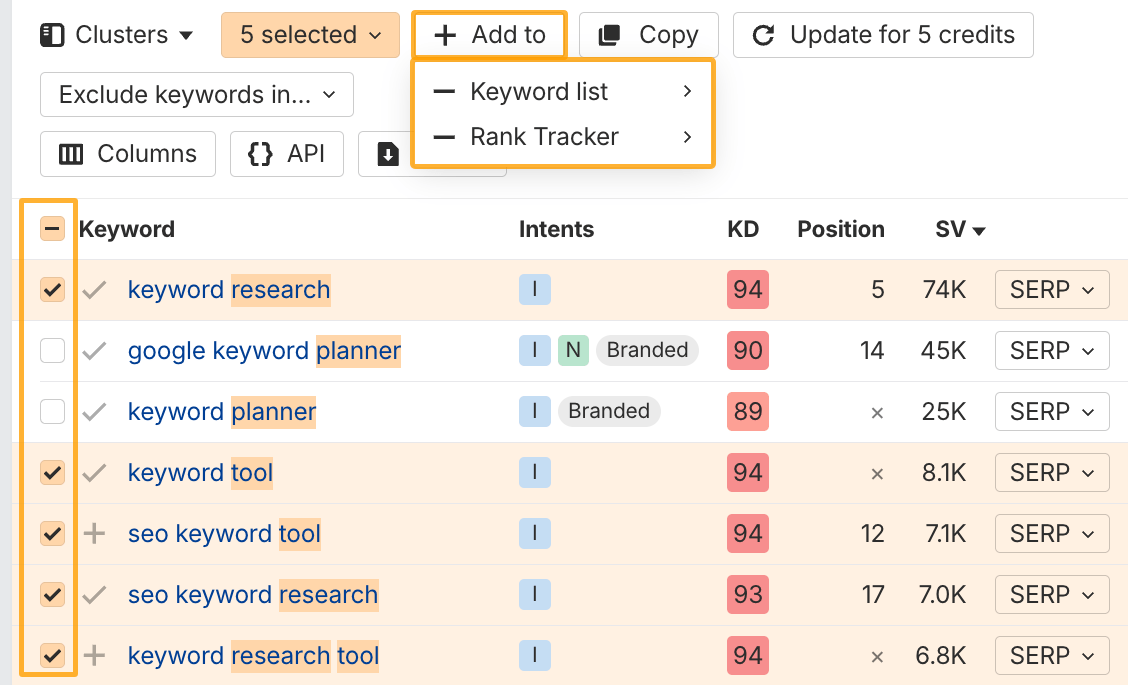
To close the topic gaps you identify, you’ll likely need to add a new page or update an existing one to cover the topic more deeply.
Related reading:
Unlike with Google search, your brand can appear in more ways in AI-generated answers on various platforms. For instance, it can be:
- Mentioned in the AI response
- Mentioned and linked in the response
- Linked as a cited source
This step builds directly on your keyword and topic analysis but shifts the focus from rankings to responses.
Use the AI Responses report in Brand Radar to find queries that don’t show your brand in the response or citation but should. Enter your brand name and review how your brand appears across different AI indexes (Google AI Overviews, ChatGPT, Perplexity, etc.).

The magic of Brand Radar lies in its filters. You can find a full tutorial here, but for now, consider these:
Use Case
Filter Settings
See what AI says about you for branded searches
Query contains {your brand}
Find branded queries for which AI references other websites (not yours)
Query contains {your brand} AND the citation does not contain {your domain}
Get stats about all your brands and sub-brands.
Query contains {your brand} AND {sub-brand 1} AND {sub-brand 2}, etc.
To perform an analysis for unbranded visibility, try searching for your topics and using the filters to show queries that don’t contain your brand. It’s easier to search each topic individually.
For instance, here are the settings looking at the topic of “keywords”:
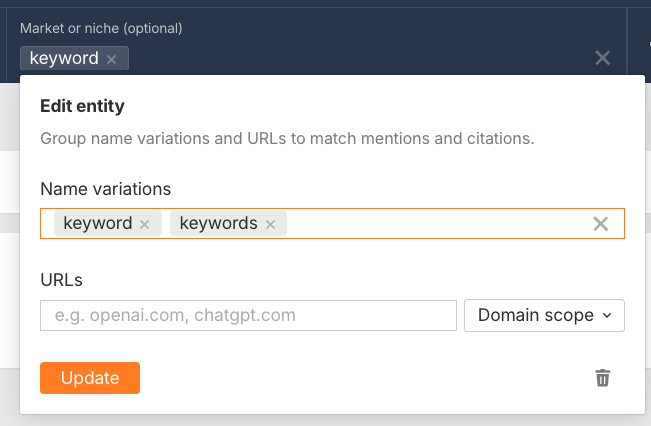
Using the filters, you can narrow down the data to specific sub-topics. For instance, I could use these settings to analyze AI responses about bottom-of-funnel queries related to keyword research and rank tracking:
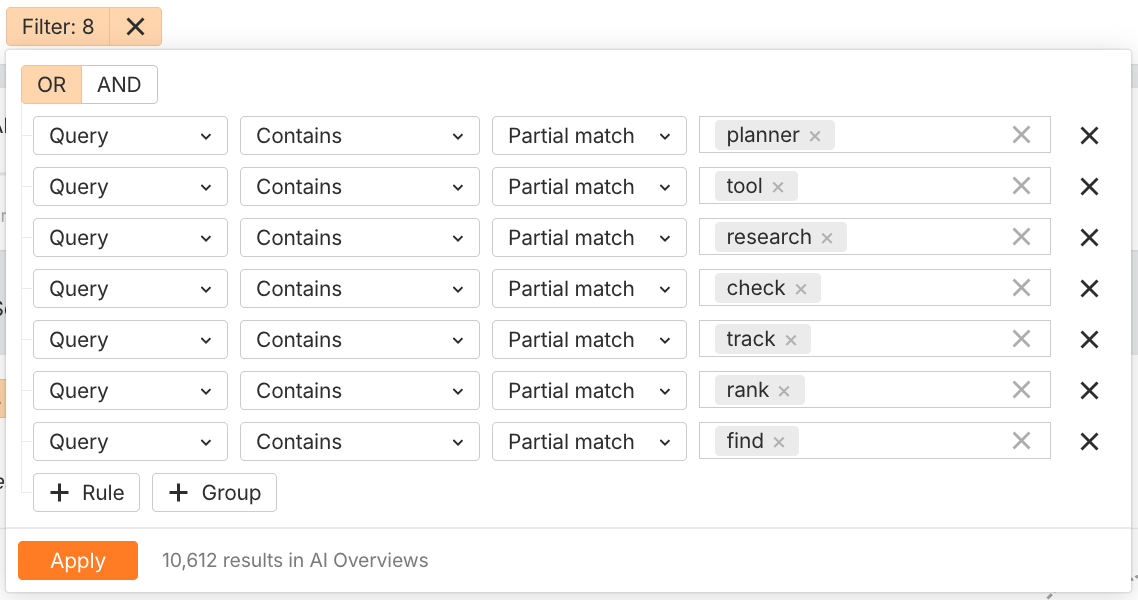
Make a list of the relevant queries where you notice gaps you’d like to close, like your brand is:
- Not mentioned, but a competitor is
- Mentioned incorrectly or alongside outdated information
- Not strongly associated with its core topics in AI responses
- Missing content formats AI frequently cites (like guides, videos, reviews)
- Mentioned in the response, but is not cited as a source
Closing these gaps often comes down to two things.
The first is closing topic gaps on your website by either publishing new pages or improving the topic coverage of existing ones.
You can use AI Content Helper for this. It analyzes your content and helps you identify essential topics to cover on each page.
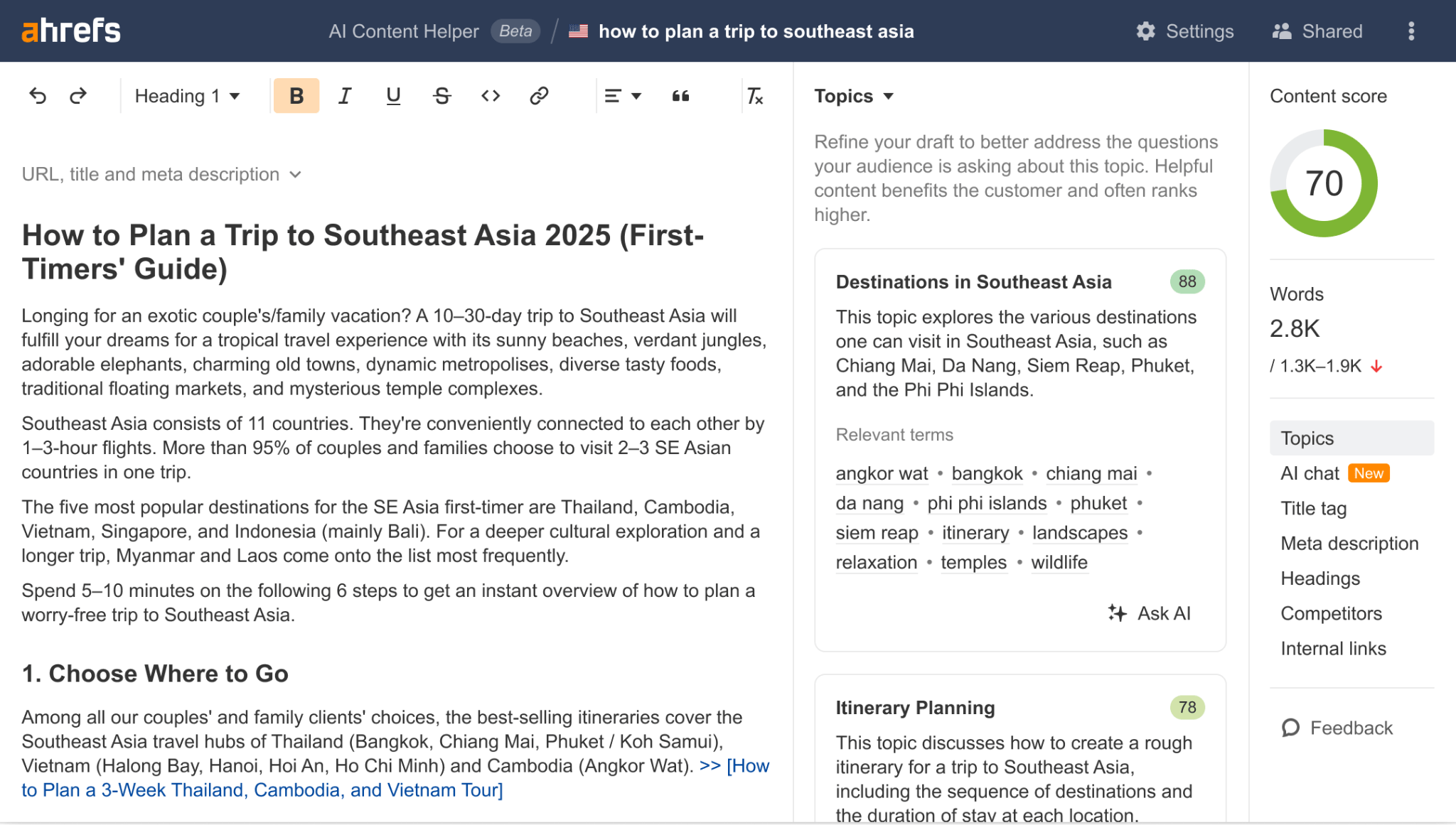
The second is by analyzing third-party websites cited in AI responses. In some cases, you may need to reach out and ask for existing information about your brand to be updated, or request to be added if competitors are mentioned but you’re not.
auditing your branded mentions comes in.
This step helps you discover who’s already talking about your brand and who should be. Think of it as mapping your brand’s share of conversation beyond search.
You can do this in the Web pages report in Brand Radar. You’ll get a list of pages that mention your brand:
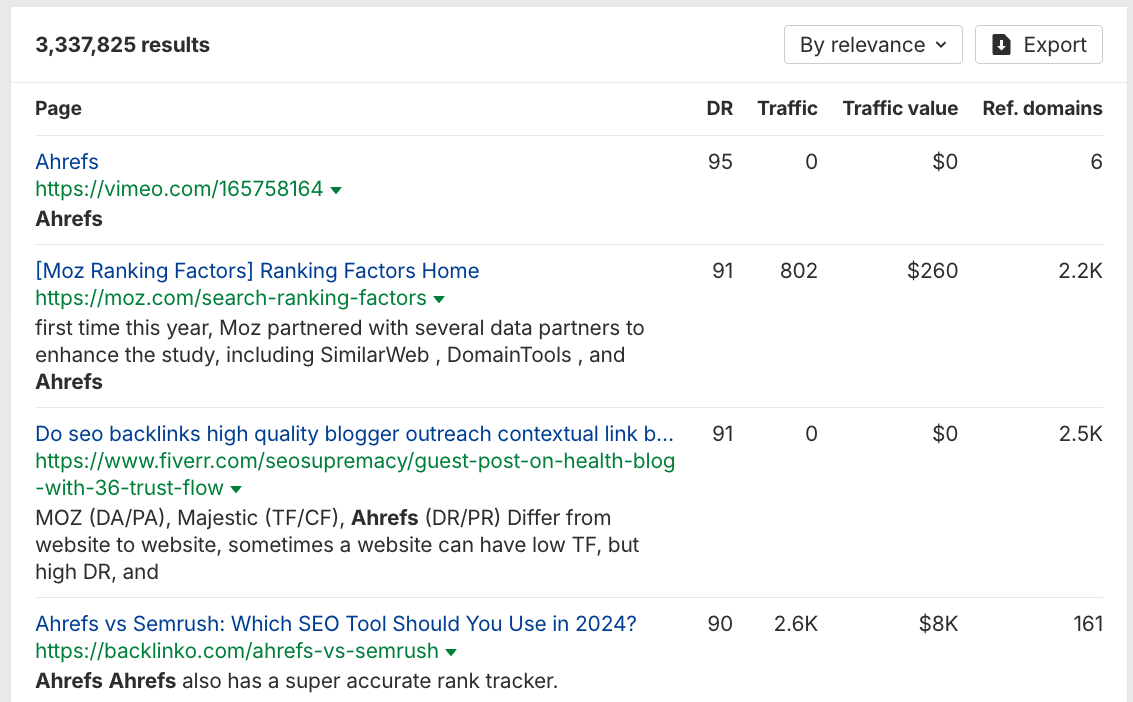
When reviewing these brand mentions, ask yourself questions like:
- What is the predominant sentiment? Are most mentions positive, negative, or neutral?
- Which brand elements show up most often? Do sub-brands, executives, or signature frameworks get more attention than the main brand?
- What types of publications mention you? News sites, industry blogs, community forums, or social platforms?
- Which formats generate stronger mentions? Case studies, product comparisons, thought-leadership articles, etc.?
- Which topics are you most often paired with? What other entities or themes consistently appear alongside your brand?
- Do mentions align with performance lifts? For example, do spikes in mentions correlate with traffic, rankings, or visibility of AI responses?
Beyond individual articles, look at who is driving the coverage.
Which authors consistently write about your competitors but not your brand? Which publications produce recurring content in your niche but rarely include you?
These authors and publications are ideal for outreach. They already engage your audience and shape your industry’s perception.
Add the ones you’d like to reach out to in a prospecting list (download ours for free if you don’t have one already 😉

capture the demand you’ve generated.
Some other things you can try to close these gaps include:
- Find easy content gaps you can close by creating new content.
- Get inspired for new product features that people search for and could influence your product roadmap.
- Align your brand to less competitive product categories if you’re up against strong competitors.
brand gap report template if you don’t already have one.
Replace all the pink sections and summarize your key findings in scorecards and quick snapshots of key points.
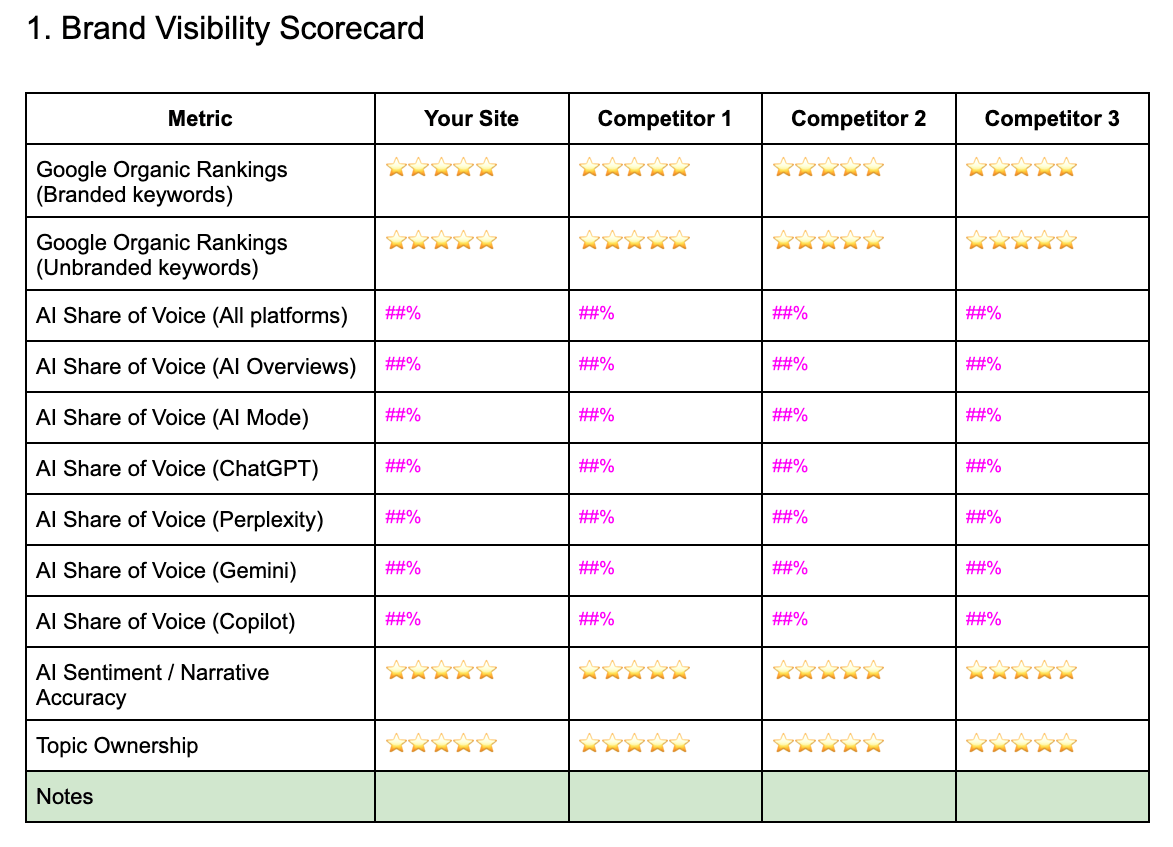
Final thoughts
A brand gap analysis should go beyond fixing individual pages. It’s not a content gap analysis. Rather, its priority is reclaiming every opportunity where your brand should have been part of the conversation but wasn’t.
Whether in Google’s top results, an AI response, or content around the web, closing those gaps compounds visibility and trust.
Similar Posts
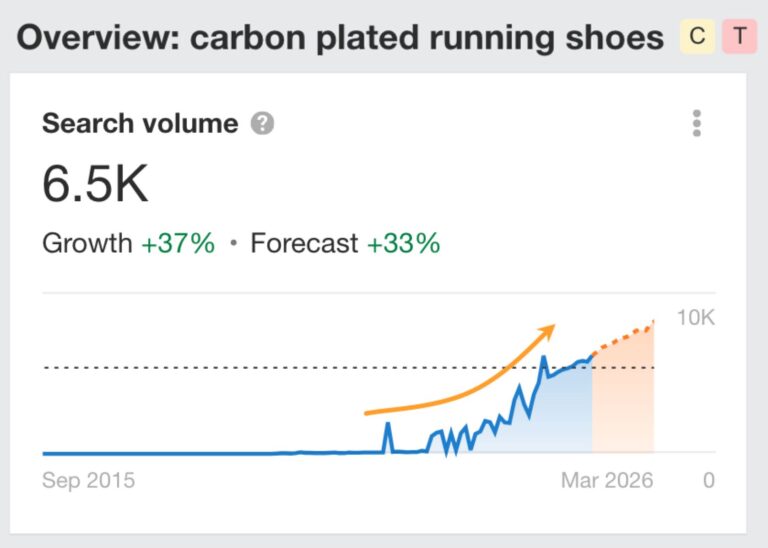
The 7 Phases of the Search Demand Lifecycle: Going Beyond Search Volume
Many junior SEOs make the same mistake: they chase high search volume, assuming it means long-term opportunity. But search volume alone is completely misleading. A keyword with 50,000 searches/month sounds like a goldmine, until you realize it’s already in decline. Investing in a fading trend is like buying MySpace stock today. Every keyword follows a lifecycle…
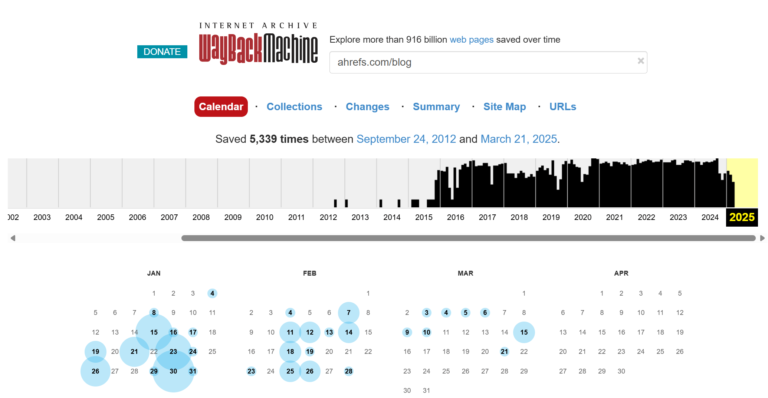
My Favorite Wayback Machine Alternatives
The internet never forgets… unless the page vanishes, the site goes offline, or the content quietly changes overnight. That’s where web archiving tools come in. They allow you to access saved versions of web pages, even if they get taken offline. The Wayback Machine is the best-known option, but it isn’t perfect—it’s slow, sometimes misses…

I Reviewed the Best AI Image Generators for 2025
I tested the most popular AI image generators to discover their greatest strengths and weaknesses. At Ahrefs, we have a team of extremely skilled (and very human) designers, but not everyone has that luxury. I wanted to know: are AI image generators useful for spinning up quick social media posts, creating blog post graphics, or…
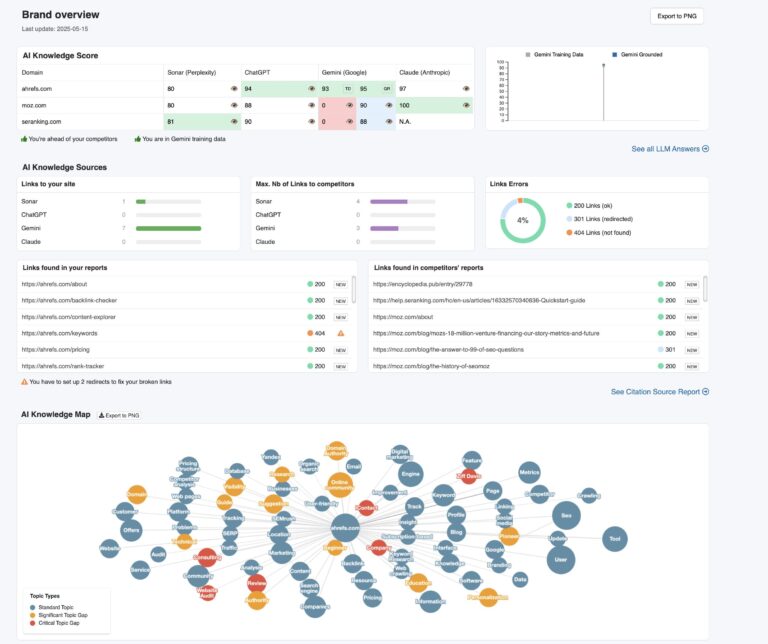
15 AEO Tools That Will Help You Optimize for LLMs
AI is reshaping search optimization—it’s no longer just about ranking in search results, but about earning visibility in AI-generated answers. We’re moving from chasing traffic, to competing for brand visibility. We’re thinking about how AI crawlers view our site–not just search engine bots. We’re trying to follow the breadcrumb trail through an entirely new kind…

AI-Generated Content Does Not Hurt Your Google Rankings (600,000 Pages Analyzed)
In 2023, Google published a blog post stating that they’re not against AI content: If you think about it, there is no clearer signal than the fact that Google has rapidly rolled out AI Overviews (and now AI mode), both of which are basically AI-generated content. Yet there are still many SEOs and digital marketers…
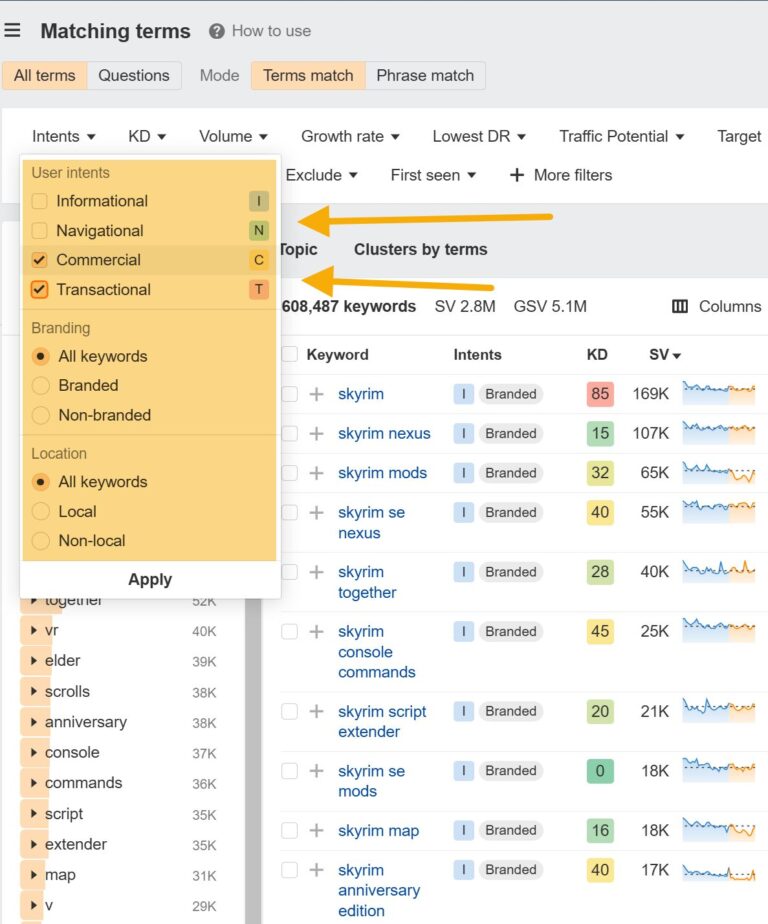
I Reviewed the Best AI Search Engines for 2025
I rigorously tested the most popular AI search engines to discover their strengths and weaknesses. I ran this test for two reasons: As a human being, I want to use the best search engine around. I spend my life on the internet. I want to find information in the fastest, most effortless way possible. As…
Brand Gap Analysis Report Template, a customizable framework to share visibility gaps, AI mentions, and opportunities for growth with stakeholders.

It includes:
- An executive summary format for leadership reporting
- Scoring tables for AI + search visibility
- Competitor insights stakeholders may be interested in
- An action plan and notes section to document next steps
Use it to make your brand’s visibility story easy to analyze, explain, and act on. Follow the process below to help you fill out each section with valuable insights.

It includes:
- An executive summary format for leadership reporting
- Scoring tables for AI + search visibility
- Competitor insights stakeholders may be interested in
- An action plan and notes section to document next steps
Use it to make your brand’s visibility story easy to analyze, explain, and act on. Follow the process below to help you fill out each section with valuable insights.
A good starting point is keyword research.
Look for recurring adjectives, modifiers, questions, and descriptive phrases people use alongside your brand or category — terms like “affordable,” “eco-friendly,” “AI-powered,” or “award-winning.” For example, IDEO has connected its brand to “human-centred” design:

These reveal the values and attributes your audience already cares about, which you can then reinforce through messaging, content, and brand signals.
For example, when looking for lawyers, many people value a firm’s ability to win without it racking up major expenses in the process:

For a plumbing service, they value a plumber who can help them at any time during an emergency:

You get the idea.
If you’re not sure what topics people search for that your brand can target, try validating some ideas through Ahrefs’ free keyword generator:

You’ll get a rough idea of the types of things people search for and how often:

As you uncover these topics and values, capture them in a structured list. They’ll serve as your benchmark for what your brand should be known and found for.
In the next step, you’ll compare this “desired state” to your brand’s actual visibility to pinpoint the gaps.
Site Explorer. You’ll get a dashboard of metrics giving you a decent baseline.
For example, you’ll get a snapshot of metrics for search performance on Google, including:
- Domain Rating (DR): A measure of the website’s strength and authority online.
- Backlinks: The number of links around the web going to the brand’s website.
- Organic keywords: The number of keywords the brand ranks for in Google search (without paying for ads).
- Organic traffic: The estimated traffic earned from organic rankings in Google search.
- Organic traffic value: The equivalent cost to earn the same traffic via Google Ads.

You’ll also get a bird’s-eye view of the brand’s visibility in AI search across different platforms:

Clicking any of these metrics will take you to Ahrefs’ Brand Radar, which shows more specific metrics related to your brand’s visibility in AI search:

- Mentions: The number of times your brand is mentioned in AI responses.
- Citations: The number of times your brand’s website is cited as a source in AI responses.
- Impressions: An estimation of exposure based on how often responses containing your brand are shown in search results.
- AI Share of Voice: How often your brand is mentioned in AI responses compared to competitors.
You can track any metrics you think matter to your stakeholders.
The list above is the minimum to get you started. It’s also a great list to revisit periodically to see how your brand’s visibility changes over time and to report the results of your efforts.
Keywords Explorer and go to the Matching terms report:

You’ll see a list of all branded terms that people search for. This report is a goldmine of brand data that comes directly from users.
You can see exactly what topics, features, and products people associate with your brand. You can also see what other brands your audience considers to be your competition.
Use the Target filter and add your brand’s website to see how well you rank for these terms:

The ideal outcome is for your website to rank in position one for all your branded keywords. But that’s not always going to be the case.
For any query containing your brand name where you’re not in the top spot, ask:
- Is the higher-ranking page from a competitor or third-party review site?
- Is it a “brand + competitor” comparison query where they outrank you?
- Is your YouTube, LinkedIn, or other owned asset ranking instead of your main site (and that’s acceptable)?
These are your branded search gaps. For each one, decide whether it’s worth closing and how to do it.
For example, for the keyword “Ahrefs YouTube”, the website ranks in position two, but by examining the search results, our branded YouTube profile ranks above the website (as expected), and therefore, there’s no gap for us to close.

However, there are quite a lot of keywords about the paraphrasing tool with decent search volumes for which the website does not rank:

In this case, it may be worth improving the on-page optimization of the page to address these gaps.
Next, take a look at how your brand performs for related unbranded searches.
Start with the list of topics you identified as relevant to your brand in step one and search them in Keywords Explorer. It’s often easier to search them one by one. Then add your website to the Target filter.
For example, Ahrefs’ visibility for the topic of “keywords” is pretty decent, but with some room for improvement:

It’s expected that anything related to “keyword planner” refers to Google’s product, not ours, so we’re not competing for visibility on those.
We’re ranking on page one for many other competitive terms around keyword generators and checkers. However, we can probably examine why our visibility for “keyword tools” in general is rather low.
As you go through the same process for your brand, it can be helpful to create a list of keywords relevant to your brand, allowing you to track your visibility for them over time.

To close the topic gaps you identify, you’ll likely need to add a new page or update an existing one to cover the topic more deeply.
Related reading:
Unlike with Google search, your brand can appear in more ways in AI-generated answers on various platforms. For instance, it can be:
- Mentioned in the AI response
- Mentioned and linked in the response
- Linked as a cited source
This step builds directly on your keyword and topic analysis but shifts the focus from rankings to responses.
Use the AI Responses report in Brand Radar to find queries that don’t show your brand in the response or citation but should. Enter your brand name and review how your brand appears across different AI indexes (Google AI Overviews, ChatGPT, Perplexity, etc.).

The magic of Brand Radar lies in its filters. You can find a full tutorial here, but for now, consider these:
Use Case
Filter Settings
See what AI says about you for branded searches
Query contains {your brand}
Find branded queries for which AI references other websites (not yours)
Query contains {your brand} AND the citation does not contain {your domain}
Get stats about all your brands and sub-brands.
Query contains {your brand} AND {sub-brand 1} AND {sub-brand 2}, etc.
To perform an analysis for unbranded visibility, try searching for your topics and using the filters to show queries that don’t contain your brand. It’s easier to search each topic individually.
For instance, here are the settings looking at the topic of “keywords”:

Using the filters, you can narrow down the data to specific sub-topics. For instance, I could use these settings to analyze AI responses about bottom-of-funnel queries related to keyword research and rank tracking:

Make a list of the relevant queries where you notice gaps you’d like to close, like your brand is:
- Not mentioned, but a competitor is
- Mentioned incorrectly or alongside outdated information
- Not strongly associated with its core topics in AI responses
- Missing content formats AI frequently cites (like guides, videos, reviews)
- Mentioned in the response, but is not cited as a source
Closing these gaps often comes down to two things.
The first is closing topic gaps on your website by either publishing new pages or improving the topic coverage of existing ones.
You can use AI Content Helper for this. It analyzes your content and helps you identify essential topics to cover on each page.

The second is by analyzing third-party websites cited in AI responses. In some cases, you may need to reach out and ask for existing information about your brand to be updated, or request to be added if competitors are mentioned but you’re not.
auditing your branded mentions comes in.
This step helps you discover who’s already talking about your brand and who should be. Think of it as mapping your brand’s share of conversation beyond search.
You can do this in the Web pages report in Brand Radar. You’ll get a list of pages that mention your brand:

When reviewing these brand mentions, ask yourself questions like:
- What is the predominant sentiment? Are most mentions positive, negative, or neutral?
- Which brand elements show up most often? Do sub-brands, executives, or signature frameworks get more attention than the main brand?
- What types of publications mention you? News sites, industry blogs, community forums, or social platforms?
- Which formats generate stronger mentions? Case studies, product comparisons, thought-leadership articles, etc.?
- Which topics are you most often paired with? What other entities or themes consistently appear alongside your brand?
- Do mentions align with performance lifts? For example, do spikes in mentions correlate with traffic, rankings, or visibility of AI responses?
Beyond individual articles, look at who is driving the coverage.
Which authors consistently write about your competitors but not your brand? Which publications produce recurring content in your niche but rarely include you?
These authors and publications are ideal for outreach. They already engage your audience and shape your industry’s perception.
Add the ones you’d like to reach out to in a prospecting list (download ours for free if you don’t have one already 😉

capture the demand you’ve generated.
Some other things you can try to close these gaps include:
- Find easy content gaps you can close by creating new content.
- Get inspired for new product features that people search for and could influence your product roadmap.
- Align your brand to less competitive product categories if you’re up against strong competitors.
brand gap report template if you don’t already have one.
Replace all the pink sections and summarize your key findings in scorecards and quick snapshots of key points.

Final thoughts
A brand gap analysis should go beyond fixing individual pages. It’s not a content gap analysis. Rather, its priority is reclaiming every opportunity where your brand should have been part of the conversation but wasn’t.
Whether in Google’s top results, an AI response, or content around the web, closing those gaps compounds visibility and trust.
Similar Posts

The 7 Phases of the Search Demand Lifecycle: Going Beyond Search Volume
Many junior SEOs make the same mistake: they chase high search volume, assuming it means long-term opportunity. But search volume alone is completely misleading. A keyword with 50,000 searches/month sounds like a goldmine, until you realize it’s already in decline. Investing in a fading trend is like buying MySpace stock today. Every keyword follows a lifecycle…

My Favorite Wayback Machine Alternatives
The internet never forgets… unless the page vanishes, the site goes offline, or the content quietly changes overnight. That’s where web archiving tools come in. They allow you to access saved versions of web pages, even if they get taken offline. The Wayback Machine is the best-known option, but it isn’t perfect—it’s slow, sometimes misses…

I Reviewed the Best AI Image Generators for 2025
I tested the most popular AI image generators to discover their greatest strengths and weaknesses. At Ahrefs, we have a team of extremely skilled (and very human) designers, but not everyone has that luxury. I wanted to know: are AI image generators useful for spinning up quick social media posts, creating blog post graphics, or…

15 AEO Tools That Will Help You Optimize for LLMs
AI is reshaping search optimization—it’s no longer just about ranking in search results, but about earning visibility in AI-generated answers. We’re moving from chasing traffic, to competing for brand visibility. We’re thinking about how AI crawlers view our site–not just search engine bots. We’re trying to follow the breadcrumb trail through an entirely new kind…

AI-Generated Content Does Not Hurt Your Google Rankings (600,000 Pages Analyzed)
In 2023, Google published a blog post stating that they’re not against AI content: If you think about it, there is no clearer signal than the fact that Google has rapidly rolled out AI Overviews (and now AI mode), both of which are basically AI-generated content. Yet there are still many SEOs and digital marketers…

I Reviewed the Best AI Search Engines for 2025
I rigorously tested the most popular AI search engines to discover their strengths and weaknesses. I ran this test for two reasons: As a human being, I want to use the best search engine around. I spend my life on the internet. I want to find information in the fastest, most effortless way possible. As…
For example, you’ll get a snapshot of metrics for search performance on Google, including:
- Domain Rating (DR): A measure of the website’s strength and authority online.
- Backlinks: The number of links around the web going to the brand’s website.
- Organic keywords: The number of keywords the brand ranks for in Google search (without paying for ads).
- Organic traffic: The estimated traffic earned from organic rankings in Google search.
- Organic traffic value: The equivalent cost to earn the same traffic via Google Ads.

You’ll also get a bird’s-eye view of the brand’s visibility in AI search across different platforms:

Clicking any of these metrics will take you to Ahrefs’ Brand Radar, which shows more specific metrics related to your brand’s visibility in AI search:

- Mentions: The number of times your brand is mentioned in AI responses.
- Citations: The number of times your brand’s website is cited as a source in AI responses.
- Impressions: An estimation of exposure based on how often responses containing your brand are shown in search results.
- AI Share of Voice: How often your brand is mentioned in AI responses compared to competitors.
You can track any metrics you think matter to your stakeholders.
The list above is the minimum to get you started. It’s also a great list to revisit periodically to see how your brand’s visibility changes over time and to report the results of your efforts.
Keywords Explorer and go to the Matching terms report:

You’ll see a list of all branded terms that people search for. This report is a goldmine of brand data that comes directly from users.
You can see exactly what topics, features, and products people associate with your brand. You can also see what other brands your audience considers to be your competition.
Use the Target filter and add your brand’s website to see how well you rank for these terms:

The ideal outcome is for your website to rank in position one for all your branded keywords. But that’s not always going to be the case.
For any query containing your brand name where you’re not in the top spot, ask:
- Is the higher-ranking page from a competitor or third-party review site?
- Is it a “brand + competitor” comparison query where they outrank you?
- Is your YouTube, LinkedIn, or other owned asset ranking instead of your main site (and that’s acceptable)?
These are your branded search gaps. For each one, decide whether it’s worth closing and how to do it.
For example, for the keyword “Ahrefs YouTube”, the website ranks in position two, but by examining the search results, our branded YouTube profile ranks above the website (as expected), and therefore, there’s no gap for us to close.

However, there are quite a lot of keywords about the paraphrasing tool with decent search volumes for which the website does not rank:

In this case, it may be worth improving the on-page optimization of the page to address these gaps.
Next, take a look at how your brand performs for related unbranded searches.
Start with the list of topics you identified as relevant to your brand in step one and search them in Keywords Explorer. It’s often easier to search them one by one. Then add your website to the Target filter.
For example, Ahrefs’ visibility for the topic of “keywords” is pretty decent, but with some room for improvement:

It’s expected that anything related to “keyword planner” refers to Google’s product, not ours, so we’re not competing for visibility on those.
We’re ranking on page one for many other competitive terms around keyword generators and checkers. However, we can probably examine why our visibility for “keyword tools” in general is rather low.
As you go through the same process for your brand, it can be helpful to create a list of keywords relevant to your brand, allowing you to track your visibility for them over time.

To close the topic gaps you identify, you’ll likely need to add a new page or update an existing one to cover the topic more deeply.
Related reading:
Unlike with Google search, your brand can appear in more ways in AI-generated answers on various platforms. For instance, it can be:
- Mentioned in the AI response
- Mentioned and linked in the response
- Linked as a cited source
This step builds directly on your keyword and topic analysis but shifts the focus from rankings to responses.
Use the AI Responses report in Brand Radar to find queries that don’t show your brand in the response or citation but should. Enter your brand name and review how your brand appears across different AI indexes (Google AI Overviews, ChatGPT, Perplexity, etc.).

The magic of Brand Radar lies in its filters. You can find a full tutorial here, but for now, consider these:
Use Case
Filter Settings
See what AI says about you for branded searches
Query contains {your brand}
Find branded queries for which AI references other websites (not yours)
Query contains {your brand} AND the citation does not contain {your domain}
Get stats about all your brands and sub-brands.
Query contains {your brand} AND {sub-brand 1} AND {sub-brand 2}, etc.
To perform an analysis for unbranded visibility, try searching for your topics and using the filters to show queries that don’t contain your brand. It’s easier to search each topic individually.
For instance, here are the settings looking at the topic of “keywords”:

Using the filters, you can narrow down the data to specific sub-topics. For instance, I could use these settings to analyze AI responses about bottom-of-funnel queries related to keyword research and rank tracking:

Make a list of the relevant queries where you notice gaps you’d like to close, like your brand is:
- Not mentioned, but a competitor is
- Mentioned incorrectly or alongside outdated information
- Not strongly associated with its core topics in AI responses
- Missing content formats AI frequently cites (like guides, videos, reviews)
- Mentioned in the response, but is not cited as a source
Closing these gaps often comes down to two things.
The first is closing topic gaps on your website by either publishing new pages or improving the topic coverage of existing ones.
You can use AI Content Helper for this. It analyzes your content and helps you identify essential topics to cover on each page.

The second is by analyzing third-party websites cited in AI responses. In some cases, you may need to reach out and ask for existing information about your brand to be updated, or request to be added if competitors are mentioned but you’re not.
auditing your branded mentions comes in.
This step helps you discover who’s already talking about your brand and who should be. Think of it as mapping your brand’s share of conversation beyond search.
You can do this in the Web pages report in Brand Radar. You’ll get a list of pages that mention your brand:

When reviewing these brand mentions, ask yourself questions like:
- What is the predominant sentiment? Are most mentions positive, negative, or neutral?
- Which brand elements show up most often? Do sub-brands, executives, or signature frameworks get more attention than the main brand?
- What types of publications mention you? News sites, industry blogs, community forums, or social platforms?
- Which formats generate stronger mentions? Case studies, product comparisons, thought-leadership articles, etc.?
- Which topics are you most often paired with? What other entities or themes consistently appear alongside your brand?
- Do mentions align with performance lifts? For example, do spikes in mentions correlate with traffic, rankings, or visibility of AI responses?
Beyond individual articles, look at who is driving the coverage.
Which authors consistently write about your competitors but not your brand? Which publications produce recurring content in your niche but rarely include you?
These authors and publications are ideal for outreach. They already engage your audience and shape your industry’s perception.
Add the ones you’d like to reach out to in a prospecting list (download ours for free if you don’t have one already 😉

capture the demand you’ve generated.
Some other things you can try to close these gaps include:
- Find easy content gaps you can close by creating new content.
- Get inspired for new product features that people search for and could influence your product roadmap.
- Align your brand to less competitive product categories if you’re up against strong competitors.
brand gap report template if you don’t already have one.
Replace all the pink sections and summarize your key findings in scorecards and quick snapshots of key points.

Final thoughts
A brand gap analysis should go beyond fixing individual pages. It’s not a content gap analysis. Rather, its priority is reclaiming every opportunity where your brand should have been part of the conversation but wasn’t.
Whether in Google’s top results, an AI response, or content around the web, closing those gaps compounds visibility and trust.
Similar Posts

The 7 Phases of the Search Demand Lifecycle: Going Beyond Search Volume
Many junior SEOs make the same mistake: they chase high search volume, assuming it means long-term opportunity. But search volume alone is completely misleading. A keyword with 50,000 searches/month sounds like a goldmine, until you realize it’s already in decline. Investing in a fading trend is like buying MySpace stock today. Every keyword follows a lifecycle…

My Favorite Wayback Machine Alternatives
The internet never forgets… unless the page vanishes, the site goes offline, or the content quietly changes overnight. That’s where web archiving tools come in. They allow you to access saved versions of web pages, even if they get taken offline. The Wayback Machine is the best-known option, but it isn’t perfect—it’s slow, sometimes misses…

I Reviewed the Best AI Image Generators for 2025
I tested the most popular AI image generators to discover their greatest strengths and weaknesses. At Ahrefs, we have a team of extremely skilled (and very human) designers, but not everyone has that luxury. I wanted to know: are AI image generators useful for spinning up quick social media posts, creating blog post graphics, or…

15 AEO Tools That Will Help You Optimize for LLMs
AI is reshaping search optimization—it’s no longer just about ranking in search results, but about earning visibility in AI-generated answers. We’re moving from chasing traffic, to competing for brand visibility. We’re thinking about how AI crawlers view our site–not just search engine bots. We’re trying to follow the breadcrumb trail through an entirely new kind…

AI-Generated Content Does Not Hurt Your Google Rankings (600,000 Pages Analyzed)
In 2023, Google published a blog post stating that they’re not against AI content: If you think about it, there is no clearer signal than the fact that Google has rapidly rolled out AI Overviews (and now AI mode), both of which are basically AI-generated content. Yet there are still many SEOs and digital marketers…

I Reviewed the Best AI Search Engines for 2025
I rigorously tested the most popular AI search engines to discover their strengths and weaknesses. I ran this test for two reasons: As a human being, I want to use the best search engine around. I spend my life on the internet. I want to find information in the fastest, most effortless way possible. As…

You’ll see a list of all branded terms that people search for. This report is a goldmine of brand data that comes directly from users.
You can see exactly what topics, features, and products people associate with your brand. You can also see what other brands your audience considers to be your competition.
Use the Target filter and add your brand’s website to see how well you rank for these terms:

The ideal outcome is for your website to rank in position one for all your branded keywords. But that’s not always going to be the case.
For any query containing your brand name where you’re not in the top spot, ask:
- Is the higher-ranking page from a competitor or third-party review site?
- Is it a “brand + competitor” comparison query where they outrank you?
- Is your YouTube, LinkedIn, or other owned asset ranking instead of your main site (and that’s acceptable)?
These are your branded search gaps. For each one, decide whether it’s worth closing and how to do it.
For example, for the keyword “Ahrefs YouTube”, the website ranks in position two, but by examining the search results, our branded YouTube profile ranks above the website (as expected), and therefore, there’s no gap for us to close.

However, there are quite a lot of keywords about the paraphrasing tool with decent search volumes for which the website does not rank:

In this case, it may be worth improving the on-page optimization of the page to address these gaps.
Next, take a look at how your brand performs for related unbranded searches.
Start with the list of topics you identified as relevant to your brand in step one and search them in Keywords Explorer. It’s often easier to search them one by one. Then add your website to the Target filter.
For example, Ahrefs’ visibility for the topic of “keywords” is pretty decent, but with some room for improvement:

It’s expected that anything related to “keyword planner” refers to Google’s product, not ours, so we’re not competing for visibility on those.
We’re ranking on page one for many other competitive terms around keyword generators and checkers. However, we can probably examine why our visibility for “keyword tools” in general is rather low.
As you go through the same process for your brand, it can be helpful to create a list of keywords relevant to your brand, allowing you to track your visibility for them over time.

To close the topic gaps you identify, you’ll likely need to add a new page or update an existing one to cover the topic more deeply.
Related reading:
Unlike with Google search, your brand can appear in more ways in AI-generated answers on various platforms. For instance, it can be:
- Mentioned in the AI response
- Mentioned and linked in the response
- Linked as a cited source
This step builds directly on your keyword and topic analysis but shifts the focus from rankings to responses.
Use the AI Responses report in Brand Radar to find queries that don’t show your brand in the response or citation but should. Enter your brand name and review how your brand appears across different AI indexes (Google AI Overviews, ChatGPT, Perplexity, etc.).

The magic of Brand Radar lies in its filters. You can find a full tutorial here, but for now, consider these:
| Use Case | Filter Settings |
|---|---|
| See what AI says about you for branded searches | Query contains {your brand} |
| Find branded queries for which AI references other websites (not yours) | Query contains {your brand} AND the citation does not contain {your domain} |
| Get stats about all your brands and sub-brands. | Query contains {your brand} AND {sub-brand 1} AND {sub-brand 2}, etc. |
To perform an analysis for unbranded visibility, try searching for your topics and using the filters to show queries that don’t contain your brand. It’s easier to search each topic individually.
For instance, here are the settings looking at the topic of “keywords”:

Using the filters, you can narrow down the data to specific sub-topics. For instance, I could use these settings to analyze AI responses about bottom-of-funnel queries related to keyword research and rank tracking:

Make a list of the relevant queries where you notice gaps you’d like to close, like your brand is:
- Not mentioned, but a competitor is
- Mentioned incorrectly or alongside outdated information
- Not strongly associated with its core topics in AI responses
- Missing content formats AI frequently cites (like guides, videos, reviews)
- Mentioned in the response, but is not cited as a source
Closing these gaps often comes down to two things.
The first is closing topic gaps on your website by either publishing new pages or improving the topic coverage of existing ones.
You can use AI Content Helper for this. It analyzes your content and helps you identify essential topics to cover on each page.

The second is by analyzing third-party websites cited in AI responses. In some cases, you may need to reach out and ask for existing information about your brand to be updated, or request to be added if competitors are mentioned but you’re not.
auditing your branded mentions comes in.
This step helps you discover who’s already talking about your brand and who should be. Think of it as mapping your brand’s share of conversation beyond search.
You can do this in the Web pages report in Brand Radar. You’ll get a list of pages that mention your brand:

When reviewing these brand mentions, ask yourself questions like:
- What is the predominant sentiment? Are most mentions positive, negative, or neutral?
- Which brand elements show up most often? Do sub-brands, executives, or signature frameworks get more attention than the main brand?
- What types of publications mention you? News sites, industry blogs, community forums, or social platforms?
- Which formats generate stronger mentions? Case studies, product comparisons, thought-leadership articles, etc.?
- Which topics are you most often paired with? What other entities or themes consistently appear alongside your brand?
- Do mentions align with performance lifts? For example, do spikes in mentions correlate with traffic, rankings, or visibility of AI responses?
Beyond individual articles, look at who is driving the coverage.
Which authors consistently write about your competitors but not your brand? Which publications produce recurring content in your niche but rarely include you?
These authors and publications are ideal for outreach. They already engage your audience and shape your industry’s perception.
Add the ones you’d like to reach out to in a prospecting list (download ours for free if you don’t have one already 😉

capture the demand you’ve generated.
Some other things you can try to close these gaps include:
- Find easy content gaps you can close by creating new content.
- Get inspired for new product features that people search for and could influence your product roadmap.
- Align your brand to less competitive product categories if you’re up against strong competitors.
brand gap report template if you don’t already have one.
Replace all the pink sections and summarize your key findings in scorecards and quick snapshots of key points.

Final thoughts
A brand gap analysis should go beyond fixing individual pages. It’s not a content gap analysis. Rather, its priority is reclaiming every opportunity where your brand should have been part of the conversation but wasn’t.
Whether in Google’s top results, an AI response, or content around the web, closing those gaps compounds visibility and trust.
Similar Posts

The 7 Phases of the Search Demand Lifecycle: Going Beyond Search Volume
Many junior SEOs make the same mistake: they chase high search volume, assuming it means long-term opportunity. But search volume alone is completely misleading. A keyword with 50,000 searches/month sounds like a goldmine, until you realize it’s already in decline. Investing in a fading trend is like buying MySpace stock today. Every keyword follows a lifecycle…

My Favorite Wayback Machine Alternatives
The internet never forgets… unless the page vanishes, the site goes offline, or the content quietly changes overnight. That’s where web archiving tools come in. They allow you to access saved versions of web pages, even if they get taken offline. The Wayback Machine is the best-known option, but it isn’t perfect—it’s slow, sometimes misses…

I Reviewed the Best AI Image Generators for 2025
I tested the most popular AI image generators to discover their greatest strengths and weaknesses. At Ahrefs, we have a team of extremely skilled (and very human) designers, but not everyone has that luxury. I wanted to know: are AI image generators useful for spinning up quick social media posts, creating blog post graphics, or…

15 AEO Tools That Will Help You Optimize for LLMs
AI is reshaping search optimization—it’s no longer just about ranking in search results, but about earning visibility in AI-generated answers. We’re moving from chasing traffic, to competing for brand visibility. We’re thinking about how AI crawlers view our site–not just search engine bots. We’re trying to follow the breadcrumb trail through an entirely new kind…

AI-Generated Content Does Not Hurt Your Google Rankings (600,000 Pages Analyzed)
In 2023, Google published a blog post stating that they’re not against AI content: If you think about it, there is no clearer signal than the fact that Google has rapidly rolled out AI Overviews (and now AI mode), both of which are basically AI-generated content. Yet there are still many SEOs and digital marketers…

I Reviewed the Best AI Search Engines for 2025
I rigorously tested the most popular AI search engines to discover their strengths and weaknesses. I ran this test for two reasons: As a human being, I want to use the best search engine around. I spend my life on the internet. I want to find information in the fastest, most effortless way possible. As…
This step helps you discover who’s already talking about your brand and who should be. Think of it as mapping your brand’s share of conversation beyond search.
You can do this in the Web pages report in Brand Radar. You’ll get a list of pages that mention your brand:

When reviewing these brand mentions, ask yourself questions like:
- What is the predominant sentiment? Are most mentions positive, negative, or neutral?
- Which brand elements show up most often? Do sub-brands, executives, or signature frameworks get more attention than the main brand?
- What types of publications mention you? News sites, industry blogs, community forums, or social platforms?
- Which formats generate stronger mentions? Case studies, product comparisons, thought-leadership articles, etc.?
- Which topics are you most often paired with? What other entities or themes consistently appear alongside your brand?
- Do mentions align with performance lifts? For example, do spikes in mentions correlate with traffic, rankings, or visibility of AI responses?
Beyond individual articles, look at who is driving the coverage.
Which authors consistently write about your competitors but not your brand? Which publications produce recurring content in your niche but rarely include you?
These authors and publications are ideal for outreach. They already engage your audience and shape your industry’s perception.
Add the ones you’d like to reach out to in a prospecting list (download ours for free if you don’t have one already 😉

capture the demand you’ve generated.
Some other things you can try to close these gaps include:
- Find easy content gaps you can close by creating new content.
- Get inspired for new product features that people search for and could influence your product roadmap.
- Align your brand to less competitive product categories if you’re up against strong competitors.
brand gap report template if you don’t already have one.
Replace all the pink sections and summarize your key findings in scorecards and quick snapshots of key points.

Final thoughts
A brand gap analysis should go beyond fixing individual pages. It’s not a content gap analysis. Rather, its priority is reclaiming every opportunity where your brand should have been part of the conversation but wasn’t.
Whether in Google’s top results, an AI response, or content around the web, closing those gaps compounds visibility and trust.
Similar Posts

The 7 Phases of the Search Demand Lifecycle: Going Beyond Search Volume
Many junior SEOs make the same mistake: they chase high search volume, assuming it means long-term opportunity. But search volume alone is completely misleading. A keyword with 50,000 searches/month sounds like a goldmine, until you realize it’s already in decline. Investing in a fading trend is like buying MySpace stock today. Every keyword follows a lifecycle…

My Favorite Wayback Machine Alternatives
The internet never forgets… unless the page vanishes, the site goes offline, or the content quietly changes overnight. That’s where web archiving tools come in. They allow you to access saved versions of web pages, even if they get taken offline. The Wayback Machine is the best-known option, but it isn’t perfect—it’s slow, sometimes misses…

I Reviewed the Best AI Image Generators for 2025
I tested the most popular AI image generators to discover their greatest strengths and weaknesses. At Ahrefs, we have a team of extremely skilled (and very human) designers, but not everyone has that luxury. I wanted to know: are AI image generators useful for spinning up quick social media posts, creating blog post graphics, or…

15 AEO Tools That Will Help You Optimize for LLMs
AI is reshaping search optimization—it’s no longer just about ranking in search results, but about earning visibility in AI-generated answers. We’re moving from chasing traffic, to competing for brand visibility. We’re thinking about how AI crawlers view our site–not just search engine bots. We’re trying to follow the breadcrumb trail through an entirely new kind…

AI-Generated Content Does Not Hurt Your Google Rankings (600,000 Pages Analyzed)
In 2023, Google published a blog post stating that they’re not against AI content: If you think about it, there is no clearer signal than the fact that Google has rapidly rolled out AI Overviews (and now AI mode), both of which are basically AI-generated content. Yet there are still many SEOs and digital marketers…

I Reviewed the Best AI Search Engines for 2025
I rigorously tested the most popular AI search engines to discover their strengths and weaknesses. I ran this test for two reasons: As a human being, I want to use the best search engine around. I spend my life on the internet. I want to find information in the fastest, most effortless way possible. As…
Some other things you can try to close these gaps include:
- Find easy content gaps you can close by creating new content.
- Get inspired for new product features that people search for and could influence your product roadmap.
- Align your brand to less competitive product categories if you’re up against strong competitors.
brand gap report template if you don’t already have one.
Replace all the pink sections and summarize your key findings in scorecards and quick snapshots of key points.

Final thoughts
A brand gap analysis should go beyond fixing individual pages. It’s not a content gap analysis. Rather, its priority is reclaiming every opportunity where your brand should have been part of the conversation but wasn’t.
Whether in Google’s top results, an AI response, or content around the web, closing those gaps compounds visibility and trust.
Replace all the pink sections and summarize your key findings in scorecards and quick snapshots of key points.

Final thoughts
A brand gap analysis should go beyond fixing individual pages. It’s not a content gap analysis. Rather, its priority is reclaiming every opportunity where your brand should have been part of the conversation but wasn’t.
Whether in Google’s top results, an AI response, or content around the web, closing those gaps compounds visibility and trust.
Similar Posts

The 7 Phases of the Search Demand Lifecycle: Going Beyond Search Volume
Many junior SEOs make the same mistake: they chase high search volume, assuming it means long-term opportunity. But search volume alone is completely misleading. A keyword with 50,000 searches/month sounds like a goldmine, until you realize it’s already in decline. Investing in a fading trend is like buying MySpace stock today. Every keyword follows a lifecycle…

My Favorite Wayback Machine Alternatives
The internet never forgets… unless the page vanishes, the site goes offline, or the content quietly changes overnight. That’s where web archiving tools come in. They allow you to access saved versions of web pages, even if they get taken offline. The Wayback Machine is the best-known option, but it isn’t perfect—it’s slow, sometimes misses…

I Reviewed the Best AI Image Generators for 2025
I tested the most popular AI image generators to discover their greatest strengths and weaknesses. At Ahrefs, we have a team of extremely skilled (and very human) designers, but not everyone has that luxury. I wanted to know: are AI image generators useful for spinning up quick social media posts, creating blog post graphics, or…

15 AEO Tools That Will Help You Optimize for LLMs
AI is reshaping search optimization—it’s no longer just about ranking in search results, but about earning visibility in AI-generated answers. We’re moving from chasing traffic, to competing for brand visibility. We’re thinking about how AI crawlers view our site–not just search engine bots. We’re trying to follow the breadcrumb trail through an entirely new kind…

AI-Generated Content Does Not Hurt Your Google Rankings (600,000 Pages Analyzed)
In 2023, Google published a blog post stating that they’re not against AI content: If you think about it, there is no clearer signal than the fact that Google has rapidly rolled out AI Overviews (and now AI mode), both of which are basically AI-generated content. Yet there are still many SEOs and digital marketers…

I Reviewed the Best AI Search Engines for 2025
I rigorously tested the most popular AI search engines to discover their strengths and weaknesses. I ran this test for two reasons: As a human being, I want to use the best search engine around. I spend my life on the internet. I want to find information in the fastest, most effortless way possible. As…

